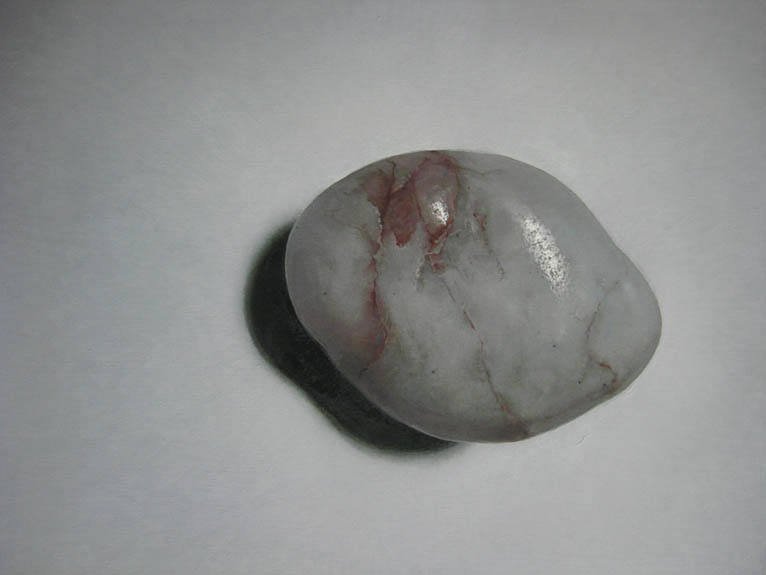ZHU YU: PLAY THINGS
| June 1, 2010 | Post In LEAP 3

The Chinese title of this show, literally “what thing,” was a bit of a tease. Without a subject, it was hard to know whether it was asking “What thing is this?” or “What thing are you?” Don’t think that the likelihood of the latter was greater than the former, unless you don’t know how clever the naming of this show really was, or don’t believe that adequate guile in a name makes or breaks an exhibition. An exhibition is an expression; only by knowing the cleverness it requires and using it well can one compel the viewer to enter and take a stance, even something along the lines of “What the hell is this?” The only person who steered clear of the trap here was the object of the show’s expression—the artist Zhu Yu, painter of the eighteen oils (nine teacups, nine pebbles) on display.
As I did not pay much attention to Zhu Yu’s 2007 series Leftover Meals, and have been more fascinated by Zhu’s reputation as a thrilling performance artist, I feel that Zhu’s identity as an oil painter is an at once delayed and sudden fact. In facing this, I finally began to suspect that an artist such as Zhu might be facing another kind of predicament. His performance art injected a heavy dose of adrenaline into our tired hearts, and ten times this amount of stimulation set off the artist’s own energy to create an explosion which not only blew a hole through art history but buried Zhu in the rubble. Nobody minded or cared about what Zhu could do under such pressure, and if he really didn’t do anything, then even he would become a fluke. Besides the energy that could continue to be wasted by the art history we are constructing, wouldn’t whatever remained be reduced to mere disposable manners?
From the Pebble to the Stain series, through Leftover Meals and back to the starting point of performance art, one can see the necessity of art history, or at least it is apparent in Zhu Yu—with one glimpse backwards a meaningful and complete world will automatically appear in your darkroom. More precisely, there are not two Zhu’s, not the oil painter Zhu and the performance artist Zhu—only Zhu. You cannot just partially accept his “Play Thing,” praise Stain and Pebble for being lifelike, imagine its Eastern aesthetics and Song and Yuan dynasty style, conjecture its Buddhist allegory and also attempt to excuse or dismiss the whiff of Realism it has always had, or pretend not to see its deeper provocation.
Don’t think that the musing in the show’s introduction—The ancients believed that stones carried within them many lives—was pure rhetorical strategy. Truly effective violence is buried under the surface in Zhu Yu’s work as in Can Xue’s novels: finely calculated down to the last detail, the stains are still stains and the pebbles still pebbles but one would never dare to meet them eye to eye.
The seemingly sparing but actually abundant visual elements in Leftover Meals cannot compare to Zhu Yu’s confidence and control in these eighteen works, which took him three years to complete; otherwise he would not possibly have entered the territory of less and less, more and more in the composition of these paintings which on the surface look largely similar. Didn’t he know how many familial backgrounds and connections art observers would point out? But it’s just as well, as Zhu uses his brush like a surgical knife—what’s hair-raising is his indifference.
This is not photorealism or any technique or method; it is an attempt by an individual to step over an impassable threshold. By comparison, Realism, which busies itself with technique and praises itself for looking “genuine,” is a mere imitation of life, a painting of bionics, its emulation relying on surface alone—how is being “genuine” enough? Throwing “truth” into disarray is to threaten it, not by twisting it but by stripping it layer by layer. Where is Zhu Yu ruthless? He has painted the world’s shameless face: seemingly beautiful, actually treacherous. He Wenzhao

